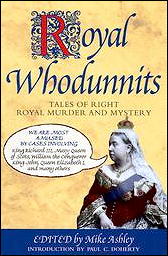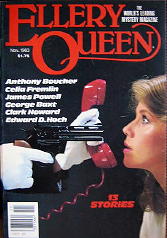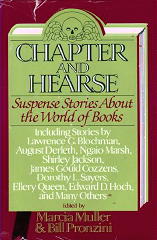Sun 13 Dec 2009
by Mike Tooney:
For Part Two of this series, go here.

7. “The Day the Dogs Died.” First appearance: Royal Whodunnits: Tales of Right Royal Murder and Mystery, edited by Mike Ashley, Carroll & Graf, trade paperback, February 1999.
“I understand, but I am no investigator, only a ship’s doctor. And an enemy besides!”
Napoleon smiled slightly. “Because you are an enemy, you are the only one I can trust.”
COMMENTS: Lt. Garrison, ship’s surgeon on one of Admiral Nelson’s men-of-war, has been captured by the French and is languishing in a Cairo prison cell when he is summoned by General Bonaparte himself. One of Napoleon’s senior commanders has died under decidedly suspicious circumstances, and Bonaparte wants to know why.
Garrison, accompanied by a man who would gladly kill him if he makes a wrong move, turns detective and exposes not merely a murderer but also a drug smuggling ring.
A brown stain, hundreds of dead dogs, and streets too narrow for carriages all figure in his solution.
NOTES: This was Hoch’s contribution to an anthology of stories with the common theme of imperial skulduggery. Among the other contributors were Martin Edwards and Mary Reed & Eric Mayer.

8. “Murder at the Bouchercon.” Ellery Queen’s Mystery Magazine, November 1983. Reprinted in Chapter and Hearse, edited by Marcia Muller & Bill Pronzini. William Morrow and Co., hardcover, 1985.
She was slumped over the writing desk near her bed. An ugly-looking hunting knife protruded from the center of her back.
COMMENTS: Mystery writer and amateur detective Barney Hamet is attending Bouchercon XIV in New York City to keep up acquaintances with his friends in the crime fiction publishing field when murder most foul is committed right in the middle of the convention.
The crime, as Barney soon learns, has something to do with Conrad Kazer, a reclusive mystery writer as elusive as Howard Hughes in his heyday — or, to be more precise, it has to do with the lucrative rights to Kazer’s works. To associate the murder with Kazer seems unavoidable because the victim leaves a dying clue: “Kazer con”.
Barney doesn’t know it at the time, but before he can leave Bouchercon he’ll come face-to-face with the murderer, an insane person with a sharp knife ….
NOTES: Barney Hamet also stars in one of Hoch’s few novels, The Shattered Raven (1969). Among the potential murder suspects at the convention are Otto Penzler, Chris Steinbrunner, Donald Westlake, Mary Higgins Clark, and Phyllis White.

9. “The Great American Novel.” Ellery Queen’s Mystery Magazine, April 1975, as by R. L. Stevens. Reprinted in Chapter and Hearse.
COMMENTS: Pete Traven works for a large New York publisher as a first reader of slush pile manuscripts. Like all editors, he harbors hopes of one day discovering that one-in-a-million submission that has Pulitzer Prize written all over it; and then it actually happens! It seems too good to be true, however, and as you can probably guess, it is.
Pete, moreover, never could have anticipated what complications would result from it: theft, impersonation, criminal conspiracy, assault and battery, and the threat of murder.
Sometimes, it would seem, book publishing can really be a cutthroat business!
NOTES: Pete is our viewpoint character, but “Stevens” (Hoch) throws in an interesting twist by having what seems to be a minor character solve the crime, so that we get not only a least likely suspect but also a least likely detective.
December 14th, 2009 at 12:38 am
I honestly believe if you asked Hoch to write a story with a cow as a detective and set in a barnyard he wouldn’t have blanched at the idea. I think the man could have fashioned a perfectly good mystery out of anything — and did.
December 21st, 2009 at 10:05 pm
[…] For Part Three of this series, go here. […]